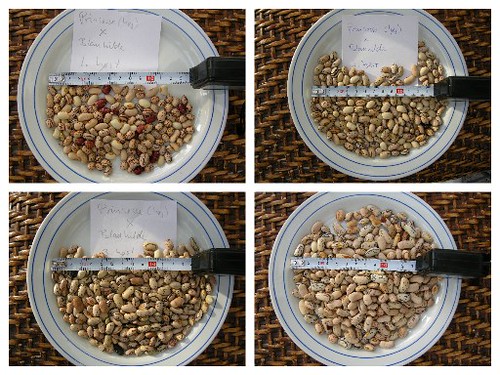
Pods of the last harvest. Phaseolus vulgaris Prinsesse NGB18186 x Blauhilde F2
The best bean cross this year was no doubt the accidental cross between Prinsesse NGB18186 og Blauhilde. It is the F2 generation I have grown, and the seeds harvested is F3. It is confusing for most people. This years F3 seeds will grow the F3 plants next year, to produce the F4 generation of seeds. A little, but for understanding these photos, important detail is, that the seed surface consist of tissue from the mother plant, thus showing us F2 fænotypes. The inside of the seeds with the embryo is F3 tissue. Keep your mind clear, or just enjoy the photos 🙂

F2 generation with a wonderful diversity
Pod shape and colour show a great diversity in this F2 generation. In next generation even more diversity may show, as genes recombine. Some of the beans er quite long. Others are curved and charming, in a way usually selected against in breeding programs. Straight pods are preferred by consumers. As a gardener, I have to find out, if I really share this view on pod shape. I’ve read about german “posthörnchen”, strongly curved wax beans, reminding of old days posthorns.

F3 bean seeds, skin is F2 tissue
Each photo in the above mosaic show the seeds from a harvest event. In the first harvest are only seeds from the early maturing individuals. In following harvest events the same individuals probably also released pods. To me the first harvest is the most important, as cold climate is a limiting factor in beans in my garden.
A few seeds are very dark. One pod in the first harvest, and one in a later harvest. The same plant must have set more pods, with a different colour. This is all normal, as patterned beans tend to make an occasional “negative”.
Leave a comment